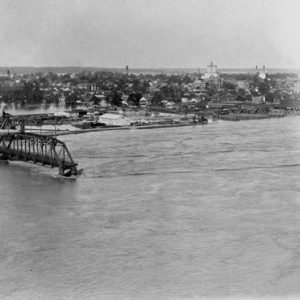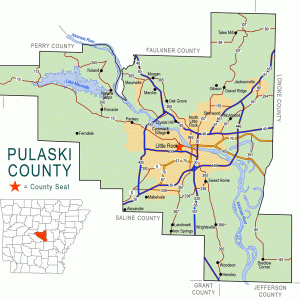calsfoundation@cals.org
Baring Cross (Pulaski County)
West of Pike Avenue in North Little Rock (Pulaski County)—across from the Union Pacific Railway shops—Baring Cross was a Pulaski County town consisting primarily of middle-class railroad workers. It took its name from the first steel bridge to span the Arkansas River in 1873. From 1896 to 1905, the municipality of Baring Cross encompassed a smaller area than it does today. North Little Rock annexed the town, which became the city’s Fifth Ward and home to several mayors and aldermen, in 1905. Following national trends, Baring Cross decayed economically in the 1960s and 1970s. Urban Renewal did little to reverse the decline, but reinvestment through the federal Neighborhood Stabilization Program as well as private investment spurred revitalization in 2010.
The name Baring Cross comes from the Baring and Company bankers of the United Kingdom, who financed construction of the Baring Cross Bridge in 1872–73 (the “Cross” portion of the name came from the company president’s family coat of arms). Prior to the building of the bridge, pioneer families Josiah M. Giles and Emanuel Boone controlled fertile bottomlands near the river west of Argenta (a town platted in 1866 and annexed by North Little Rock in 1904). In February 1873, the Arkansas Gazette wrote that Baring Cross “has one or two small wooden dwellings, and two large railway buildings. The ground is covered with main and side tracks, which run in every direction.” A freight depot was “full to the ceiling” because freight had to be loaded into wagons to travel via ferry.
As the railroad flourished, so did the community west of Pike Ave. The St. Louis, Iron Mountain and Southern Railway built a twelve-stall frame roundhouse and machine shop along Pike that replaced a smaller building. In 1888, the Iron Mountain, which was acquired by Missouri Pacific Railway, built a twenty-eight-stall brick roundhouse. Drainage of the Baring Cross swamp in 1890 made more expansion possible. Dedicated in 1984, the $40 million Downing B. Jenks Shop overhauls diesel engines for Union Pacific.
Pike Ave. was the main street of Baring Cross. By 1900, three hotels, a community hall, stores, and restaurants drove residential and commercial activities in a town of 389. Thriving businesses included Vestal Florist Company and Arkansas Industrial Company, a brick and tile manufacturer known as the Brickyard. Wary of potential annexation of Baring Cross by Little Rock (Pulaski County), forty-four residents successfully petitioned for municipal incorporation in 1896. Baring Cross elected its first mayor, Mord Roberts, and five councilmen. Roberts, a master mechanic for the railroad, developed housing between 7th and 11th streets.
The town annexed Vestal Addition to the west in 1899 and Baring Cross Addition north to 15th Street in 1903. The North Little Rock Times noted in 1898 that seventy-five pupils attended Baring Cross School. The Baring Cross Baptist Church was founded in 1903. Walter B. Metz, a folklorist reared in Baring Cross, wrote of a hardscrabble life, explaining that “families were large, money was scarce and three square meals a day was actually a luxury.” In October 1905, U.S. president Teddy Roosevelt visited Baring Cross on his way from Fort Roots to Little Rock.
Flooding in 1927 inundated Vestal nurseries during the community’s worst natural disaster. Recalling one family’s plight, historian Evelyn K. Eubank said the family’s home was buried in deep mud. Shifting economics in the 1960s, exacerbated by middle-class flight to suburbia, interstate highways, and urban renewal, brought further problems for Baring Cross.
Baring Cross expanded east of Pike Ave. and north to Pershing Boulevard. Pike Plaza Shopping Center opened in 1959, and Memorial Hospital operated atop the Giles family’s Blackberry Hill from 1962 until 1999. The North Little Rock Housing Authority with federal funding constructed the $2.4 million Heritage House high-rise at 22nd and Division for elderly and disabled people in 1967. In the 1970s, urban renewal programs and the city invested about $4.5 million between 15th and 27th streets, but the area’s downturn persisted. Pike Ave. at 18th Street—the heart of the business district, with grocery stores, a movie theater, and numerous businesses by the 1960s—was a shell of itself by the 1990s. Poverty and crime took a toll.
In 2010, the city invested $8.4 million through the federal Neighborhood Stabilization Program for housing construction and public works in lower Baring Cross. Private investment has also rehabilitated homes and holds the potential for future development. The city and federal governments built a $1.9 million traffic roundabout at Pike, Broadway, and Riverfront Drive—one of the first in the area. Third Street was extended west as Rockwater Boulevard, linking with a marina and apartments on the former Vestal site. A Vestal smokestack was preserved as a central feature of the new roadway.
For additional information:
Adams, Walter M. North Little Rock: A History: The Unique City. Little Rock: August House, 1986.
———. “The Railroads of North Little Rock.” Unpublished manuscript, 1980. North Little Rock History Commission, North Little Rock, Arkansas.
Baring Cross Reference File. North Little Rock History Commission, North Little Rock, Arkansas.
Bradburn, Cary. On the Opposite Shore: The Making of North Little Rock. Marceline, MO: Walsworth Publishing Company, 2004.
Dillard, Tom W. “The Luther Burbank of Arkansas: Joseph W. Vestal and the Company He Created.” Pulaski County Historical Review 49 (Fall 2001): 50–55.
Joseph W. Vestal Reference File. North Little Rock History Commission, North Little Rock, Arkansas.
Urban Renewal Annual Reports—1967, 1968, 1970, and 1973–74. North Little Rock History Commission, North Little Rock, Arkansas.
Vestal, Sarah. “Joseph Wysong Vestal’s Horticultural Legacy, Sweet Potatoes to Blueberries.” Pulaski County Historical Review 67 (Fall 2019): 70–83.
Walter B. Metz Collection. North Little Rock History Commission, North Little Rock, Arkansas.
Cary Bradburn
North Little Rock History Commission
 Baring Cross Bridge; 1927
Baring Cross Bridge; 1927  Baring Cross Bridge
Baring Cross Bridge  Pulaski County Map
Pulaski County Map 



Comments
No comments on this entry yet.